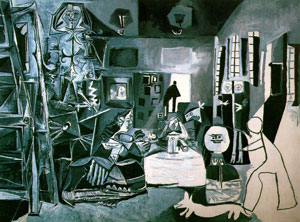What can market researchers learn from the Picasso Museums of Barcelona and Paris?
 Posted by Ray Poynter 5 January 2019
Posted by Ray Poynter 5 January 2019
In October last year I was lucky enough to be in Barcelona and visited the Museu Picasso and this month I am in Paris and have visited the Musée Picasso. Whilst the two visits had much in common, there were some interesting differences in the way the curation had been done, and this led me to think about the lessons for market research and insights. These two visits and the curation led to further ideas which might be applied to market research.
The link between
storytelling and curation
The process of curation is a form of storytelling. There should be an overarching
message that the curator is looking to share, and there should be a narrative
flow that helps the visitor navigate the exhibition and that leads to the
discoveries and realisations that the curator had hoped for.
In Barcelona the narrative theme was built around chronology, the exhibition started with some of Picasso’s earliest works and proceeded to show how his work changed and developed during his lifetime, from paintings that showed the world as we normally see it through different media (e.g. paint, fabric, ceramics) and different forms of abstract.
In Paris, the curation focused on specific works of art, showing the sketches that helped create it, the reaction of the media and public, and the broader context. This curation emphasised how much work was involved in creating something that, when seen as a finished item, might appear effortless. Another aspect of the Paris curation was to display some of Picasso’s own collection, for example, paintings from people such as Henri Matisse – knowing who Picasso respected/collected helps informs the appreciation of Picasso’s work.
In your market research presentation or report, have you curated the material? Have you created a narrative that will lead to discoveries?
Curation, like storytelling, means leaving things out
Neither the Barcelona or Paris galleries include everything they have, in order to create a story (an exhibition) they include and they exclude material. In the case of art galleries, there are two elements of including and excluding elements. There are artefacts they possess that they do not include (because they are not part of this particular story). There are also artefacts which they might want to use but do not possess (because they in other collections). In these cases, the curator will usually work with a subset of what it owns, but it will also borrow items from other collections when possible.
In your insights debrief, have you left out material that is not part of the narrative? Have you sought to include relevant material from elsewhere? (For example, including a previous project, a published report, or interviews with stakeholders.)
Ideas for insights and Market Research Drawn
from the Works of Picasso
These themes are mostly from these two museums, but of course they build on
earlier visits to Picasso exhibitions and viewing the work of other artists.
- Creativity is hard work. The final painting we see is based on time, sketches, mistakes, breakthroughs etc. If you want to buy a great report, expect to pay for time and effort as well as for skill and vision.
- The need to keep evolving. The work we do when we are 25 should not be the work we do when we are 35, or 45, or 55 or 65. Just because we used to produce 100-page reports does not mean we should do them now, we must grow and develop.
- Collect multiple perspectives and re-visit assumptions. Picasso often re-visited great works of the past and created multiple perspectives of what he saw. A good example of this in the Museu Picasso in Barcelona is the collection of 58 paintings he produced in 1957 based on his analysis of the 1656 painting, Las Meninas, by the Spanish painter Diego Velázquez. One of Picasso’s 58 paintings and Velázquez’s original are shown at the bottom of this post, both are links to Wikipedia images.
- Showing more can reduce clarity. Cubism was an interesting movement in art, and Picasso was one of its key pioneers. Instead of showing a single representation of how one person might see something from a single angle (something a camera can usually do better), cubism breaks the object into facets, rearranging views from different angles to create a two-dimensional view that represents multiple perspectives. Perhaps market research and insights will need this approach one day – but remember art invented cubism when it had mastered perspective, impressionism, realism, and many other forms – and we in market research have not really mastered the basics of insight reporting yet.


One thought on “What can market researchers learn from the Picasso Museums of Barcelona and Paris?”
Comments are closed.
It is defined in the best way and this indeed would be helpful for all those who need to see what basically this museum is all about.